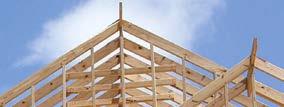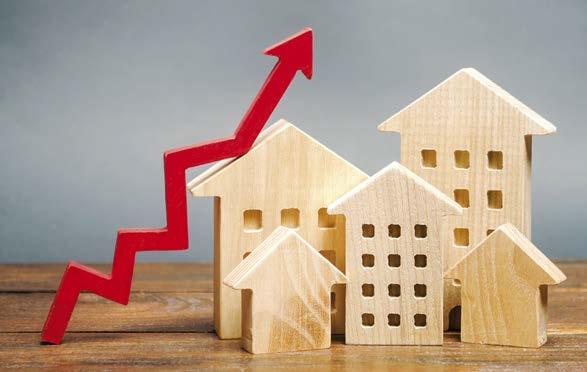
8 minute read
A material matter
Product shortages, rising costs and soaring demand are making it difficult for homebuilders to keep pace. BY CAITIE BURKES
MANCHAC HOMES owner Russell Alleman is arguably the busiest he’s ever been, with demand exceptionally high for the custom homes he builds in the Greater Baton Rouge market.
The only problem: He can’t acquire the materials he needs to build each house. At least, not easily.
In recent weeks, it’s been increasingly difficult for Alleman to source wood needed for roof decking. On one recent job, after phoning nearly every lumber supplier in his rolodex with no luck, he was prepared to drive to a lumber yard in Mississippi before a nearby supplier called Alleman at 5 a.m. to tell him a shipment had just arrived.
“We ran over there at 6 a.m. to pick it up, and paid a fortune because we had to,” Alleman says. “We knew it wouldn’t be there long at all. If I had to guess, they probably sold out by lunch.”
Alleman’s predicament—which also extends to windows, appliances and, considering the recent flooding, sheetrock—is one that’s familiar to many Baton Rougearea homebuilders, who are juggling these various supply chain issues and material cost increases in a time of unprecedented buyer demand.
As a result, newly constructed homes are slower to come online, meaning the cost is being passed onto buyers. In East Baton Rouge Parish, for instance, the median price of a home rose from $209,000 in 2019 to $225,000 in 2020—a 7.6% uptick, according to the Greater Baton Rouge Association of Realtors. It’s a significant jump, given that between 2015 and 2019, the median home price in EBR increased just 1.4% on average.
Alleman, who exclusively does cost-plus contracts, recently ran a transaction report for a client whose 3,600-square-foot, $1.1 million home would have been $64,000 cheaper had it been built just 16 months ago. He chalks up much of the 6% increase to lumber prices—which, though they’re on the decline, remain 125% higher than the 15-year average.
“Everyone knows that lumber has been ridiculous—there’s no sweeping this under the rug,” Alleman says. “I know lumber prices have finally started to go down, and I hope it stays that way.”
Nonetheless, for potential homebuyers, the current supply problem only makes existing real estate all the more attractive. And they’re rushing to scoop up homes now rather than later, while interest rates remain historically low.
The big question becomes: At what point does the single-family market stabilize in Baton Rouge, with sales prices cooling off and months supply returning to its usual six-month level?
The apparent answer: Whenever interest rates jump, which the Fed has signaled will begin in 2023.
SUPPLY PROBLEM: Though there are recent signs of easing, a shortage of lumber and other building materials has increased construction costs and delayed completion of new houses.

housing is far outpacing supply, but there’s not much suppliers can do about it.
Nowadays, local builders like Tyler Watson, who owns Distinctive Homes, often find themselves back-and-forth on the phone with suppliers, who are grappling with skeleton crews on top of shortages of building materials.
While it used to take only two weeks for windows to arrive, Watson says that lately it has been averaging 12 weeks.
“By that time, I’m normally putting cabinets in the house or painting and getting toward the finishing stages,” Watson says. “Three months is insane.”
Additionally, appliances are four to five months out, he says, a phenomenon that has also helped slow the building process.
A massive labor shortage doesn’t help, either. Watson’s subcontractors have limited crews, which Watson attributes to the extension of federal stimulus checks.
Still, homes are being built. Already, in the first quarter of 2021, building permits throughout the Baton Rouge MSA were 30% higher compared to the first quarter of 2020, according to data provided by the Home Builders Association of Greater Baton Rouge.
Over the past 12 months, building material costs have soared 26.1% across the U.S. on average, according to the National Association of Home Builders/ Wells Fargo Housing Market Index. The previous record was 6.1% in 2017.
“It’s the same story here,” says Karen Zito, president and CEO of the HBA of GBR. “But construction loan appraisals struggle to reflect these extremely high-rising costs.”
In June, the Housing Market Index showed that builder sentiment fell to its lowest level since August as construction costs pushed new home prices higher, making it more difficult for smaller builders—who account for two-thirds of the homebuilding market—to get loans.
Appraisals have tended to lag where market prices and
TIMBER TALE
Construction on a client’s $1.1 million home would have been $64,000 cheaper if built 16 months earlier. Manchac Homes builder Russell Alleman says much of the cost increase is tied to lumber prices, which are 125% higher than the 15-year average.

ISTOCK
construction costs are. Low appraisals mean that builders either need more equity or they cannot proceed with the loan.
All of which makes it more expensive for builders to build, causing the industry to decelerate its pace.
DEMAND REMAINS HIGH, FOR NOW
With newer builds slower to come online, the existing home market is experiencing something of a frenzy, to put it lightly.
How much of a frenzy? So much, that many homes are selling without an appraisal clause, with clients offering tens of thousands of dollars above asking price and, in some cases, agreeing to let the seller live, rent-free, in the house for a month after the closing. They’re also waiving certain contingencies, like the right to inspect a house before buying.
“Escalation clauses are being used fairly frequently within our market right now,” says Connie Kyle, managing broker of CJ Brown Realtors in Baton Rouge. “You’re seeing this trend play out because we’re getting multiple contracts on each house.”
Essentially, if a bidding war erupts on a home, the escalation clause will automatically raise the buyer’s offer on the house by a predetermined increment, up to the maximum amount the buyer authorizes. These kinds of clauses are particularly useful in a competitive real estate market where homes get multiple bids.
Kyle says it has required real estate agents to get more savvy, but she views these trends as a positive sign for the market as a whole.
“We’ve seen a lot of upper-end properties sell this year,” Kyle says. “It’s a stronger market across the board than I’ve seen in a long time.”
What’s driven buyer demand to new heights, according to local real estate experts, is the fact that 30-year mortgage rates have remained below 3%.
Tom Cook, an appraiser with Cook, Moore, Davenport and Associates and who’s been in the business for 40 years, can’t remember the last time he saw rates this low.
“The money is almost free,” Cook says. “There’s so much demand right now, I don’t see it ending unless (President Joe) Biden inflates prices and increases interest rates.”
Say, for example, interest rates rise from 3% to 6%. A monthly mortgage payment on a $300,000 home would rise from $1,265 to $1,800. Therefore, in order to qualify for the same mortgage loan, the average borrower in Baton Rouge—who brings in a median family income of $57,000 yearly—would have to earn an additional $1,500 monthly, or $18,000 more annually, Cook says.
“That person would have to get a 31% pay raise to buy the same house,” Cook says. “A lot of people would be out of the market.”
Put another way, every $1,000 increase in the cost of building a home prices out more than 360 homebuyers in East Baton Rouge Parish, according to Zito.
Yet, as Kyle points out, any potential rise in interest rates would be “minimal” compared to pre-
vious years. While she, Cook and Zito don’t anticipate a 2008-style “pop,” there could be other ramifications, such as prospective buyers being more limited in the price point of homes they can purchase.
With supply also limited, it isn’t likely the market will see prices decline, but it’s reasonable to assume prices will cool off by the time interest rates creep up and the prices of lumber and other materials level out.
WHAT’S NEXT
Lumber prices are falling, but homebuilders say they’re still not where they need to be.
In early May, lumber futures surged to unprecedented heights, peaking at more than $1,600 per thousand board feet. Since then, however, they’ve tumbled to $900.80 per thousand board feet as mills restarted or ramped up production and some customers put off their purchases until prices came down.
Still, that’s high compared to recent years; between 2009 and 2019, prices averaged less than $400 per thousand board feet.
“Even though prices are falling, it’s still going to be at least 30 to 60 days before local lumber suppliers see that effect,” Zito says. “It won’t be any easier to source the productivity between now and the end of the year.”
However, the fact that prices are trending downward at a rapid pace is still a good sign for the market, other experts say.
“There’s too much competition in the lumber industry, so companies are more inclined to produce,” Cook says, “and there’s no shortage of trees to cut.”
Meanwhile, recent economic indicators seem to show that all the easy money will trigger inflation. In May, the Consumer Price Index rose 5% compared to last year, the fastest pace in 13 years.
Moreover, the Federal Reserve has considerably raised its expectations for inflation this year and indicated that interest rate hikes could come as soon as 2023, after saying in March that it didn’t foresee any increases until at least 2024.
The HBA of GBR is working with its national organization to address the housing affordability crisis at the federal, state and local levels by informing elected officials about the challenges the industry is facing.
“We’re keeping an eye on inflation and the unemployment situation,” Zito says. “As an industry, we’re looking for an opportunity to evolve and adjust to a new normal.”

RIPPLE EFFECT
Housing demand is rising but high construction costs and a lagging finance market are slowing the completion of new homes, causing prices on existing inventory to escalate. Building material costs have soared 26.1% across the U.S. in the past year, according to the National Association of Home Builders/Wells Fargo Housing Market Index. The previous record was 6.1% in 2017.











